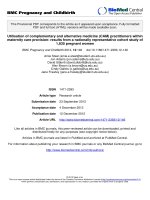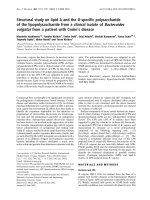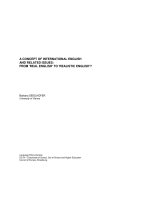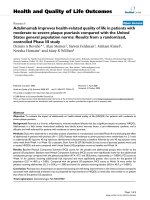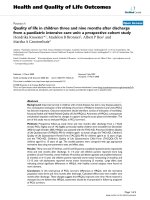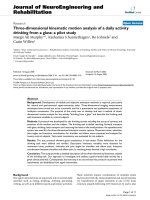RNIB International AD Exchange Study Observations from a focus group study
Bạn đang xem bản rút gọn của tài liệu. Xem và tải ngay bản đầy đủ của tài liệu tại đây (145.45 KB, 30 trang )
RNIB International AD Exchange Study
Observations from a focus group study
Report published: May 2011
Written by Sonali Rai
Media and Culture Department
Royal National Institute of Blind People
105 Judd Street
London
WC1H 9NE
Telephone 020 7391 3270
Fax 020 7387 7109
Email:
Project Steering Group
Heather Cryer
Angela Edwards
Joan Greening
Anna Jones
Leen Petré
Acknowledgments
Thanks to all the workshop participants who advised on the
project and gave their comments and suggestions.
Also, sincere thanks to the project steering group for
reviewing and commenting on the content of the
various drafts and advising on the project.
A special thanks to WGBH for contributing audio-visual
material with audio description.
2
RNIB International AD Exchange Study
TABLE OF CONTENTS
RNIB INTERNATIONAL AD EXCHANGE STUDY..........................................1
EXECUTIVE SUMMARY................................................................................. 4
1. INTRODUCTION......................................................................................... 6
...................................................................................................................... 23
APPENDIX 1: OFCOM CODE ON TELEVISION ACCESS SERVICES........24
APPENDIX 2: TOPIC GUIDE FOR FOCUS GROUP SESSIONS.................27
REFERENCES.............................................................................................. 30
3
Executive Summary
Introduction
Audio Description (AD) is like a narrator telling a story. It is an
additional commentary that describes body language, expressions
and movements, making the story clear through sound. AD is often
relied upon by blind and partially sighted people in the same
manner as subtitles are relied upon by deaf and hard of hearing
people.
The development of AD has been quite fragmented across the
world. In the UK, AD is currently available across television
channels, cinemas, home entertainment products such as DVDs,
Blu-ray discs and on two online catch up players. Many other
countries have made AD available on different media platforms as
has been found practical and feasible. They may not necessarily
call the narrative track audio description; instead several other
terms are used such as video description and descriptive
narration. Descriptive Video Service®, registered trademark of
WGBH created for its video description service is one such term
that is quite often used in the US. For consistency and ease of
reading, we will use the term 'AD' in this document.
With the availability of AD increasing across many countries in the
world, it is time to look at the exchange of these access features
between countries e.g. AD tracks as assets with the original
content. The exchange of television content between countries is
common practise these days as is the production of DVDs for
multiple regions so such a system of AD exchange would ideally
minimise any duplication, thereby bringing down production costs
and resources allocated to the production of AD. With film
companies releasing DVDs and Blu-rays of film/s across many
countries, it is now possible to include the same AD track on
DVDs/ Blu-rays being released across a number of countries. A
very successful and existing example of this exchange would be
DVDs and Blu-rays currently being released in Australia with AD
tracks that were produced by UK film distributors primarily for UK
audiences.
However, since the primary target of these AD tracks is the
community of blind and partially sighted people, it is important that
their views are taken into consideration before any such system is
put in place.
4
Therefore, this study sought to establish whether or not
internationally produced AD would be acceptable to blind or
partially sighted regular AD users in the UK.
Key findings
• A majority of blind and partially sighted participants expressed
that the origin of AD, produced locally within the UK or imported
from another country, made no difference to them as long as the
description was of good quality and helped them keep up with the
action on the screen.
• Participants were keen to point out that they would much rather
have internationally produced AD than no AD at all so if exchange
of AD meant more programmes with AD, then it would be more
than welcome.
• Some participants felt that if the country of origin of AD was the
same as of the programme, then the AD would potentially fit in
better with the programme, as the accent (e.g. American English)
would remain same throughout
5
1. Introduction
1.1 Background
In contrast to the widely accepted misconception that blind and
partially sighted people do not watch television/ films, a needs
survey carried out by RNIB in 1991, showed that 94 per cent of
blind and partially sighted people watch films/television regularly
(RNIB, 1991). In 2006 Research by the University of Birmingham
found that around 87 per cent of blind and partially sighted people
regularly watch TV and videos or DVDs. The broadcast media
plays an important role in the lives of blind and partially sighted
people by providing access to news, information and
entertainment. (Douglas, G., Corcoran, C., Pavey, S. (August
2006) Network 1000)
AD is an additional commentary to a film/television programme,
which describes body language, expressions and movements. It
gives people information about the things that they might not be
able to see, so that they can keep up with the action on the screen.
It takes away the dependence of relying on someone else to fill in
the gaps.
The majority of Hollywood distributors such as Warner Bros, Disney,
Fox, Paramount, Pathe and Sony Pictures increase the accessibility
of their films by providing subtitling for deaf and hearing impaired
audience and AD for blind and partially sighted people on almost
100% of their UK releases. In addition, about 40% of the cinemas in
the UK are equipped with special equipment that delivers AD to
viewers in the cinema. It is delivered at every screening of the film
via a headset as long as it is playing in an accessible screen of the
cinema. The description comes through the headset and the film
soundtrack comes from the cinema surround sound. With the dawn
of the new digital cinema age, it will soon be technically possible to
have AD on every single show of a film as long as the cinema has
infra-red headsets and the required system to support the headsets.
The digital system eliminates the need for special equipment to
deliver AD as it can be placed on one of the tracks on the hard drive
that contains the film media unlike 35mm prints.
The AD track is quite often also carried over on to the DVD and Bluray release of the film in the UK.
However, it is television that has emerged as the largest area for
6
audio described programming in the UK. As per the
Communications Act 2003, ten per cent of the programming on
digital terrestrial/ cable/ satellite television must be broadcast with
AD by the fifth year of a digital license being issued. A number of
broadcasters such as BBC, Sky, Channel 4, and most recently ITV
have committed to providing AD on at least twenty per cent of their
programming.
It is important to note here that the development of AD is relatively
widespread across many other countries and it is no longer a UK
phenomenon. AD is available across different platforms in
Germany, France, USA, Australia and Canada. Whilst it may not
be as extensively available as in the UK, this presents an
opportunity for the exchange of AD files with the assets that are
regularly exchanged with the TV programmes to avoid duplication.
As long as the content is available in the same language across
countries (e.g. content in English in the English speaking
countries, content in French in French speaking countries) the
possibility exists for AD files to be exchanged with the original
content.
There are two main benefits of this potential exchange:
1. Reduction in duplication and consequently costs incurred for the
production of AD since AD files will be shared amongst
broadcasters for mutual benefit.
2. By sharing existing AD, broadcasters will have more capacity to
produce AD for other programmes thus increasing the overall
quantity of AD
Of course, another potential outcome may be that broadcasters
see this as a cost saving opportunity and it could result in the
introduction of internationally produced AD tracks without any
increase in the total amount of AD being delivered on TV.
Since the primary audience for AD is blind and partially sighted
people, it is important to consider their views on the introduction of
internationally produced AD before any concrete steps are taken in
this direction. In the UK context, this could very well be AD produced
in America, Australia, New Zealand, Canada or any other English
speaking country. Therefore, the main purpose of this study is to
seek feedback from blind and partially sighted people in the UK on
AD that has been produced internationally.
7
1.2 In-depth analysis of UK AD and Internationally
produced AD
In early July 2009, RNIB exchanged some audio described content
with WGBH Boston, AD provider in the US for simple evaluation
and forming some initial "expert staff" views on the differences and
similarities between AD produced in the UK and internationally
produced AD. AD is also referred to as Descriptive Video Service
[DVS ®] in the US.
Analysis carried out by AD experts in the UK and US have been
included in this report and can be found in Chapter 4.
1.3 Aims and objectives
The aim of this study was to explore the potential for the
international exchange of AD files for TV or films on DVD/ Blu-ray, by
gathering feedback from regular users of AD within the UK on
internationally produced AD. Areas of particular interest included:
• to what extent would the participants feel positively or negatively
about internationally produced AD
• to what extent factors such as local accents and dialects,
different terminology, and style of AD may affect users' enjoyment
• Whether participants would express preference for a particular
style of AD - UK or internationally produced AD
8
2 Method
2.1 Design
In order to understand the views and opinions of AD users on the
subject of internationally produced AD, a qualitative approach was
chosen for this research. Focus groups were used to allow
discussions between users.
2.2 Participants
Ten regular and enthusiastic users of AD were recruited as
participants by RNIB's Media and Culture Department. These
people were existing contacts and known to be regular users of
AD. The international exchange of AD focus group session was
hosted at the RNIB offices in London.
Background information about participants was collected prior to
their taking part in the focus group sessions. This included:
demographic information (age, gender); sight condition (self
report); how sight condition affects TV viewing; and extent of
weekly TV viewing with AD.
Demographic information
• Three participants self reported as partially sighted and seven
as blind
• Six had congenital sight problems whereas four had acquired
sight loss
• Six participants were male and four female
• One participant was aged between 25-34; two between 35-44;
two between 45-54; three between 55-64; one between 65-74
and one 85+
Sight Conditions
Participants had a wide range of eye conditions affecting their sight
• Retinitis Pigmentosa - two participants
• Retinal problems - two participants
• Retinopathy of prematurity - one participant
• Nerve damage - one participant
• Stroke - one participant
• Rubella - one participant
• Macular dystrophy/Stargardt - one participant
• Monocular vision - one participant
9
How sight condition affects TV viewing
• Five participants reported that they could not see anything on
the TV screen
• Two participants reported having difficulty seeing the picture,
fine detail and text on the TV screen and were unable to see the
light of the TV screen
• One participant reported having difficulty seeing the picture, fine
detail and text on the TV screen
• One participant reported having difficulty seeing fine detail and
text on screen and were unable to see the light of the TV screen
• One participant reported having difficulty seeing the fine detail
and text on the TV screen
Extent of weekly TV viewing with AD
• Four participants watched around 20 hours of audio described
television per week
• Two participants watched between 10-14 hours per week
• Three participants watched between 4-7 hours per week
• One participant only watched audio described films on DVD
2.3 Materials
There were two key areas investigated in this research• Impact of internationally produced AD on international
programmes
• Impact of internationally produced AD on a programme written
and produced in UK.
The media used for this research were 15-minute clips from each
of the following programmes:
1. CSI Miami (an American programme) - AD produced by WGBH
Boston. The clip had been selected because of its style and
content, it asked for a significant quantity of description. AD in this
clip was deemed vital for understanding the clip independently.
2. Miss Marple (a programme produced in the UK therefore with
English accent) - AD in American accent produced by WGBH
Boston
In contrast to the clip from CSI Miami which is a highly visual fast
paced crime thriller series with slick editing, participants were now
asked to watch a clip from the British television series Miss Marple.
The mystery series is based on a character created by the novelist
Agatha Christie in the early 20th century who is quite often seen
10
knitting or working in her garden in the programme. The format of
Miss Marple is much slower and more relaxed in nature when
compared to CSI. The basic idea of choosing these two clips was
to make the participants hear the American AD on an American
show and then make them listen to American description on a
British show.
2.4 Procedure
Participants were split into two groups of five for the focus groups.
Each focus group included partially sighted and blind participants
and was led by a facilitator. Initial questions covered participants'
existing views on the idea of international exchange of AD,
particularly considering potential benefits and drawbacks of such
an exchange.
Following this discussion, all participants came together to view
the first demonstration clip, of 15 minutes from an episode of CSI
Miami, an American TV programme with American AD. Having
watched the clip together, participants went back to their original
groups to discuss their experience of the clip. Participants were
asked to focus on the AD itself, rather than the genre of the
programme, which may or may not have appealed to their taste.
Following this discussion, participants came back together to view
the second demonstration clip, 15 minutes from Miss Marple, an
English programme with American AD. Again, participants
returned to their groups to discuss their experience. Final
questions covered participants' acceptance of international AD for
British and international programmes.
The facilitator of each focus group used a set topic guide, in annex
2.
3 Focus Group Discussions
3.1 Initial impressions of internationally produced AD
Initial impressions were sought from participants on what they
thought about the concept of importing AD tracks from other
English speaking countries such as US, Australia, New Zealand
and Canada for television programmes and films.
To initiate the discussion, groups were asked to identify potential
benefits and drawbacks of such an exchange.
11
• Can you think of any benefits to the international exchange
of audio description?
A number of potential benefits of international AD exchange were
identified. Some of the participants felt that with the introduction of
international AD, UK broadcasters will be able to allocate existing
resources to the production of AD for programmes that currently do
not carry any AD at all. In addition to this, some also stated that
American AD would fit better with American programmes because
of similar accents and other relevant features.
•
Benefits
"I actually watched a film with American AD and it was
quite relaxing hearing the description within the [same
accent] language…it's not just making sure the AD is
fine but making sure the voice is matching up with the
film…..I think I went to see Shrek where all these
people were talking in animated voices and I found
the English AD very distracting because the person
who was doing the description was quite soft spoken
and it jarred me out of the film."
"I suppose there is one way of looking at it, if we did
use international AD then we may have more
programmes with it!"
The following three quotes were voiced consecutive to each other.
"[It could mean] saving money"
"[It could mean] more audio description"
"More audio description - yes!!!"
• Disadvantages
Most of the participants did not seem to have any firm
reservations about internationally produced AD at this point;
therefore views expressed during this discussion were really
questions that people had in mind. These included potential of
problems with different usages of language, different styles of
AD, and inclusion of subtitles where some accents may be
difficult to understand.
12
"My only take on it is, if I'm watching Upstairs
Downstairs I [would] actually like the audio describer
to be in that mood of accent and speaking."
"[What] I'm thinking of is and I've no examples of it as
such, that we and the Americans are a country
divided by the fact that we speak the same language
but differently. So that might pose a problem."
"In the UK, we are used to a more descriptive AD
track whereas the AD tracks produced in the US, well
at least the ones that I have heard, are more matter of
fact. So I am not sure if they would fit and vice versa,
of course!"
3.2 Discussion- AD on CSI Miami
Participants watched a 15-minute clip from CSI Miami with AD
produced in the US and then split into two groups same as before
to discuss the AD that they had just heard. Participants were now
asked to comment on their experience of internationally produced
AD.
3.2.1 What did you think of the AD?
Participants were asked to put aside whether or not if it would be
the genre of programme that they would otherwise choose to
watch while at home, and think particularly about the AD.
• Prompt 1- Compared to the AD that you use now, were
there any differences?
As regular users of AD in the UK, participants were able to pick out
the differences between the UK AD and American AD quite quickly.
These differences included voicing of credits at the beginning of
the show, faster pace of the AD track, additional details in the
description. Despite identifying differences in the description,
participants felt that none of them seemed instrumental enough to
lose interest in the show:
"I was a bit surprised when the credits started - we're
so used to hearing that at the end of the programme
it's a different method of describing but the details
were very good."
13
"It was put together really well, it was easy to
understand, the American dialect didn't bother me
personally at all. It was fast moving, but as it was a
fast moving programme it seemed to fit in very well."
"I thought it was good. Enhanced the programme
because my wife watches CSI and I don't, and one of
the reasons why I don't [watch CSI] is because the
action happens so quickly. They keep flashing
between different scenes and I find that hurts my eyes
and I can't concentrate on it. With the AD, I was
actually able to follow for the first time what was
actually going on in a CSI programme."
"I'm so used to the English description so I found it
strange at first but I did start to get used to it and I'm
sure in time I would completely get used to it. But it
was a bit rapid fire and I do think unfortunately that
you need a bit of time to assimilate, contemplate, and
to meditate on what you're seeing. You do need a
pause to absorb a film. I did get used to it - to the
American accent - it was okay and I'm sure in the
interest of standardisation I would have to vote for it."
• Prompt 2- Was there anything that you liked about the
audio description in this clip?
Various factors seemed to impact the enjoyment of participants
watching the first clip with American AD. These included the AD
being easier to understand as it fitted better with the programme,
and better sound levels.
"It was very nicely mixed, easy to hear over the
background noise."
"I really liked the American description, it was easy to
follow [….] I almost found myself looking towards the
screen subconsciously because it held my interest, it
was easy to distinguish between the dialogue and the
describer.
"For me, because English is a second language it's
the same amount of concentration whether it's British
or American English. I don't mind especially if that
14
means it [programmes] can always be audio
described."
• Prompt 3- Was there anything that you disliked about the
audio description in this clip?
The most significant issue that emerged from this discussion was
the pace of the AD track and the fact that it probably had too much
information which some people found hard to process, (though this
may have been a feature of the programme, rather than the AD
itself). Other aspects disliked by participants included the
presentation of the credits, and use of some unfamiliar
terminology.
"The pace of it - it shouldn't be an intrusion - the AD - I
don't want the audio describer to win an Oscar."
"It was almost quite relentless and I completely
appreciate that it was a very fast moving programme
and lots of things were happening and it was
switching from different locations and all of that was
very good. They did a very good job of switching
locations and all that sort of stuff - but personally I just
found myself thinking ' I've got a headache'."
"It was just a little bit too fast, rapid."
"I didn't like the way credits came in the middle of
nowhere. It seemed disjointed."
3.3. Discussion - AD on Miss Marple
Having viewed the clip from Miss Marple, with American AD,
participants were asked to comment on their experience.
3.3.1. What did you think of the AD track?
Once again participants were reminded to focus on the AD rather
than the genre and content of the programme.
• Prompt 1 – Compared to the AD that you use now, were
there any differences?
The majority of the participants wore a puzzled look when they
were asked about the difference in AD that they normally used in
the UK and this AD track that had been produced in the US. The
quotes below summarise what participants said in response to this
15
question, seeming to pick on the faster pace of the description and
the different terminology.
"It seemed a little bit faster than what you would get in
the UK description. But it was easy to follow."
"I did notice a few times. The different terminology
they have for things. I was left wondering what a
caravan was."
"No, I didn't see any difference at all."
• Prompt 2- Was there anything that you liked about audio
description in this clip?
Although participants struggled to identify differences between the
American AD and British AD for Miss Marple, it seemed they found
it easier to pick the aspects that they really liked or even disliked
during the focus group session. Aspects liked by participants
included content of the description, voice of the describer, and a
sense of engagement with the programme
"I thought that this is not going to fit - because of the
American twang. But safe to say there are as many
different American accents as there are English
accents - she had a very soft refined American
accent. It's all about being in context with what it is. It
was brilliant - in the end she did it so well, so
professionally that I forgot about her accent."
"I think it's the quality and the quantity of description
that we're actually looking for rather than who actually
reads it - what accent they've got. As long as you've
got the quality and the quantity and it blends in well
with the programme and it's clear."
"It's also the feeling, the sense of the programme that
the describer has. The American woman describing
Miss Marple - she seemed to just have a sense for
the content of the programme. That's so important."
"I could have sat and listened to that for however long
it went on because it was quite a pleasant North
American voice."
16
• Prompt 3- Was there anything that you disliked about the
audio description in this clip?
Some participants identified differences in the description which
they did not like, such as missing details about how people looked,
and having a different style to UK AD, often using the terms 'now'
and 'later' and repeating the names of characters in a scene.
"The details were missing about how people looked. I
like to know how people look. What their features are
- I can imagine by the voice but I like to know how
they look."
"I was a bit sceptical at first - but it worked very well.
Didn't detract very much but given the choice I would
prefer an English describer."
"Being honest it was okay - but it didn't really work for
me. I know I'm being picky but how many times did
she use that word 'later' and 'now'. I got fed up with
hearing her name [the characters]. There were only
two of them in the room but she kept repeating the
girl's name all the time and the boy's name. "
This discussion was followed by two more general questions on
the international exchange of AD model rather than the clips
themselves. Since participants had experienced internationally
produced AD first hand, they were now able to offer more
substantial responses in comparison to the start of the session
when only a few of them had actually experienced internationally
produced AD.
3.4 Foreign Accents
At this point participants were asked, now that they had seen both
the clips, American programme with American AD and a British
programme again with American AD, if it made any difference to
their viewing experience.
Foreign accents was one of the areas identified by a RNIB AD
expert who had analysed the clips before the focus group
sessions, to pick out any potential areas that may act as barriers
for regular AD users in the UK. Instead of asking the participants
directly if the accent would pose an impediment in their enjoyment
17
of the clip, participants were left to single it out as a significant
factor once they had seen both the clips. Below are a selection of
quotes that mention foreign accents:
"It didn't make any difference to me actually - we’re so
used to hearing American voices now, American
accents all the time. I read audio books read by
Americans. It doesn't really bother me."
"I think if it does promote higher output of AD for us or
globally then that's a very positive action from that.
The more time allowed - if this does happen - I think
the ears and the brain will get used to it anyway."
"I'm listening to so many American Audio books that I
really don't care anymore if it's British or American. I
don't care. I enjoyed it the same as I do an American
movie with British AD. I don't mind - I'm just happy
AD is available."
3.5 Support for the exchange
Having had some demonstration of internationally produced AD,
participants were now asked, generally speaking, if they would
support the idea of international exchange of AD. The discussion
that followed this question, almost in effect, mirrored the discussion
that had previously taken place after the clips had been played.
The conflicting statements below sum up discussion:
"Did anyone have an idea about what the characters
looked like…? For me that is very important so it did
not really work for me that much"
"Facilitator/s: So generally speaking would you
support the idea of International Exchange of AD?
Participants [almost in unison]: Yes
Facilitator: An overwhelming answer?
Participant [and everyone else nodded in agreement]:
"the more stuff we can get the better."
18
4 In-depth analysis - AD comparison between
UK and US material
4.1 UK Analysis of material described in the US
Author: Joan Greening
After having watched the WGBH Boston programmes- Miss
Marple and CSI Miami with American AD, two areas seem to
emerge where the US audio description conflicts with the UK
Ofcom Best Practise Guidelines. These are as follows:
• Ofcom Best Practice Guideline 6 [see Appendix 1] states
'When to describe: Audio description should not encroach on
dialogue'. Numerous examples were found where the US
description was clashing with the programme dialogue, thrice
during 'CSI' and on 35 instances in 'Miss Marple'
• Ofcom Best Practice Guideline 8 [See Appendix 1] states
'Delivery: 'Avoid the term ‘we see’.'
The AD track on CSI was written from the viewpoint of the person
watching the TV programme e.g. - "Now an aerial view sweeping
over rooftops. We drift down …. We lift away into the sky ….."
• Additional differences between the US/UK AD
There are three key areas where the US AD differs from the UK
AD.
• Language and Cultural Differences:
Although both the US and UK have English as their common
language, there are many differences in our use of words
and phrases. The following examples were found in the
programmes supplied:
• Garbage/Trash [UK - rubbish]
• Tarp [UK - tarpaulin]
• Asphalt [UK- tarmac]
• Fender [UK - wing]
• Sedan [UK - saloon/Bentley/Rolls Royce]
• Jeweller's loupe [UK - jeweller's eye glass]
• Trunk - [UK - boot]
• Ocean - [UK - sea as 'Miss Marple' is set in the English
countryside and the UK is surrounded by seas not
oceans.]
19
• Castle - [UK - country mansion/estate. "Castle" conjures
up a very specific image to a UK audience. There were
no castles in 'Miss Marple'.
• Castle wall [UK - estate wall].
• Use of adverbs:
US description uses 'Now' as a way of indicating a scene
change, e.g. "Now in a church"; "Now at the licence office".
In the UK we use intonation to indicate a scene change e.g.
"In a church", "At the licence office". "Now" was used 23
times in 'Miss Marple' and repeatedly in the episode of 'CSI'.
Similarly there is a repeated use of "later" in US description.
UK description tends to use "later" when there has been a
passage of time in the same setting. In 'Miss Marple', there
were 9 uses of the word "later" which in the UK we would
simply have described what was happening - "In a bedroom"
rather than "Later in a bedroom".
To sum up, the US materials are broadly in line with the Ofcom
Best Practise Guidelines however there are additional areas of
difference which include language and cultural differences, and
use of adverbs in the AD.
4.2 US Analysis of material described in the UK
Author: WGBH
Boston Descriptive Video Service [alternate name for AD in the
US] staff and others listened to UK samples on 25/9/09
Los Angeles DVS staff listened at various times
• Review of Bleak House
• the “bundled” descriptions let the drama play out
uninterrupted – a good technique
• we noticed less use of short descriptions (1 sec., 2 sec.) than
our usual practice
• of course, there are language and word differences:
"cupboard" for "closet," "lorry" for "truck," "lift" for "elevator." It
was suggested that describers should use language
culturally relevant to the source of the production; WGBH’s
DVS staff does this at times (e.g., use of "boot" for "trunk,"
20
especially when characters in the production use those
words themselves)
• UK describers seem to use less scene-change description
than we are used to and wonder if this might leave the
viewer a bit lost
The audio mix was better for Bleak House than for the other
programs we listening to: Mad Men, 2-1/2 Men, Monk,
Brothers & Sisters
• Review of Sitcoms (situation comedies: i.e., “Two-and-aHalf Men”)
• the audio mix seemed jarring when a laugh track was
present (in the sitcoms). There are little-to-no sitcoms
described in the U.S., so laugh track issues as they effect the
mix are not common
• there is certainly less space/time for adding description in a
sitcom
• the description script seemed to have more "attitude" or
“edge” (in 2-1/2 Men in particular); we tend to be more
“removed” except for kids programs
• Review of Monk
• due to lack of space/time in the program, there did not seem
to be enough description for mystery-solving and
understanding by blind audiences
5. Conclusion
The small sample size and non-random selection of the
participants prevents these findings from being used to generalise
the results to the wider population. The results from this study
show that the use of internationally produced AD on UK or
international programmes would not have any impact on the
enjoyment of programmes but that does not necessarily represent
views of all AD users.
The two focus groups were unanimous in their view on the use of
internationally produced AD. However it is noteworthy, while their
views were positive on the introduction of internationally produced
AD as it may potentially lead to an increase in the percentage of
audio described content on television, they were concerned about
the quality of AD. So as long as the quality of AD was maintained,
21
they were happy to use the AD that was produced in any part of
the world.
Key Findings:
• The single most important factor that emerged from this research
was the availability of AD as it made all the difference in the
understanding of the television programme/ film.
"I think if it does promote higher output of AD for us or
globally then that's a very positive action. I think the
ears and the brain will get used to it anyway and I
would really consider it but if it's too bad then I'd
switch it off - and then ask what's happening? It
needs to be of a good quality from both sides of the
pond really."
• The majority of blind and partially sighted participants expressed
that the origin of AD, produced locally within the UK or imported
from another country, made no difference to them as long as the
description was of good quality and helped them keep up with the
action on the screen.
"As long as you've got the quality and the quantity
and it blends in well with the programme and it's clear.
To me it doesn't matter if it's an American person
describing it on an English programme or the other
way around."
"We could have theirs if it's the same quality as ours.
For me the whole thing hangs on standards."
• Some participants felt that if the country of origin of AD was the
same as the programme, then the AD would potentially fit in
better with the clip, as the accent (e.g., American English) would
be the same throughout
"I would like an American movie with an American
audio describer."
"It's about quality, although accent does come into it."
22
6. Recommendations
Following on from this study to examine AD preferences, it is
recommended that broadcasters and AD providers in different
countries carry out a further study to explore the various possibilities
that exist for AD exchange:
• Practical implementation of this exchange system of fully
produced AD files
• Exchange of AD scripts only, which can then be adapted as per
scheduling patterns followed in different countries for example., 2
commercial breaks in a 30 minute programme or 4 commercial
breaks in a 30-minute programme.
This study only gives the perspective of potential users without
going into the technical intricacies of any exchange of AD files.
23
Appendix 1: Ofcom Code on Television
Access Services
1. What to describe: to the extent relevant to the storyline, audio
description should describe characters, locations, time and
circumstances, any sounds that are not readily identifiable,
on-screen action, and on-screen information.
2. Characters: identifying and describing characters is vital to
effective audio description. Key features should be identified
as soon as practicable, to help identify the person in the
listener’s mind’s eye and avoid the need for long-winded and
confusing descriptions, e.g. ‘the tall man’, ‘district attorney
Lopez’. But do not give the name away if the plot requires the
character’s identity to be revealed at a later date. When
describing characters, aspects such as dress, physical
characteristics, facial expression, body language, ethnicity
and age may be significant. Don’t shy away from using
colours or describing a character as pretty, or handsome,
where relevant to the story. Generally names (rather than ‘he’
or ‘she’) are used more often than in normal speech, so as to
avoid confusing the audience, particularly when there are
several people taking part in a dialogue.
3. On-screen action: wherever possible try to describe at the same
time as the action occurs. This is particularly important with
regard to comic situations, where the audience, sighted and
visually impaired, should be able to laugh at the same time.
Where relevant, key back-references can be included. It may
be necessary to set up the next scene during the current
description.
4. Settings: when describing locations, try to cover scene changes
where possible. the locations (including scene changes
wherever possible); the time of day/season/date setting where
appropriate; any sounds that are not readily identifiable; and
on-screen information (e.g. signs, hieroglyphics, open
subtitles for foreign languages, captions, and opening and
closing credits).The description should not censor what is on
screen. However, it should not be necessary to use offensive
language, unless (for example) when referring to content that
24
is integral to understanding the programme, such as graffiti
scrawled on a wall.
5. What not to describe: the description should only provide
information about what can be seen on the screen.
Information unavailable to the sighted viewer should not be
added though discretion is always necessary. ‘A turreted
bridge over a city river’ would fall short if the sighted audience
sees London’s Tower Bridge , even without an identifying
caption. Generally, ‘filmic’ terms such as camera angles
should not be used.
6. When to describe: audio description should not encroach on
dialogue, important or complementary sound effects, or critical
sound effects unless really necessary. Even then, audio
description should only be used to impart relevant information
when the dialogue or other sound is inconsequential, or to
read subtitles or on-screen captions. To differentiate between
subtitles and description the describer should do this by either
the use of their voice (e.g. stating the obvious, ‘He says in
Russian…’ or ‘A caption reads…’) or a second voice. During
opening titles and end credits, care should be taken to avoid
clumsy overlaps with song lyrics. During songs, audio
description should ideally where there is a reprise of the lyrics
and where the lyrics are not relevant to the storyline.
7. Language: audio description provides a real-time commentary,
so should generally be in the present tense (he sits), the
continuous present (he is sitting) or the present participle
(‘Standing at the window, he lets out a deep sigh’ ), as
appropriate. Variety is important, particularly with verbs. ‘She
scuttles into the room’ rather than the simple fact ‘She enters
the room’ creates a clearer image for the viewer (a Thesaurus
is always useful). Adverbs are a useful shorthand to
describing emotions and actions, but should not be subjective.
Vocabulary should be matched to the genre of the
programme, and should be accurate, easily understood, and
succinct.
8. Delivery: delivery should be steady, unobtrusive and impersonal
in style (but not monotonous), so that the personality and
views of the describer do not colour the programme. Avoid the
term ‘we see’. However, it can be important to add emotion,
25




